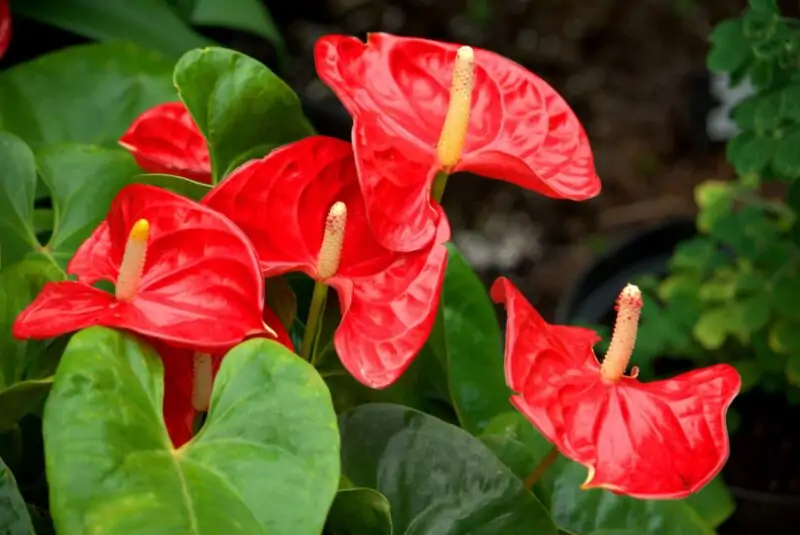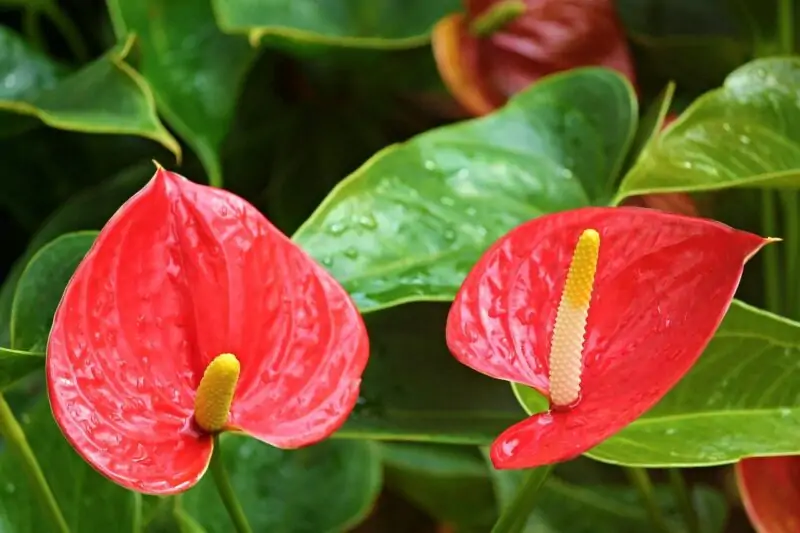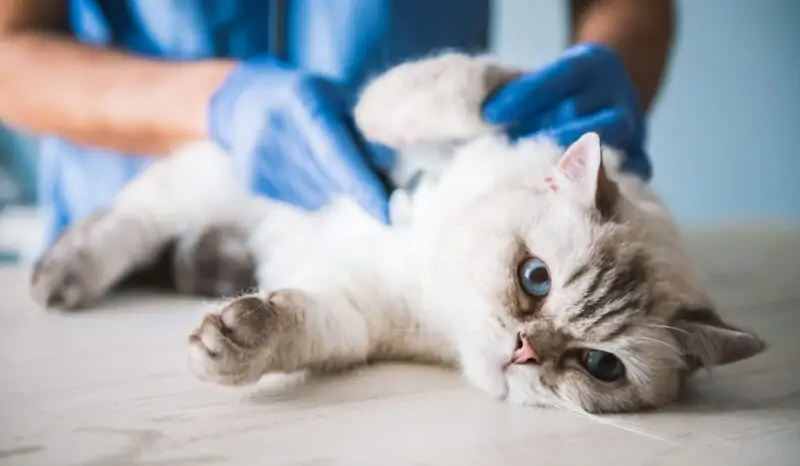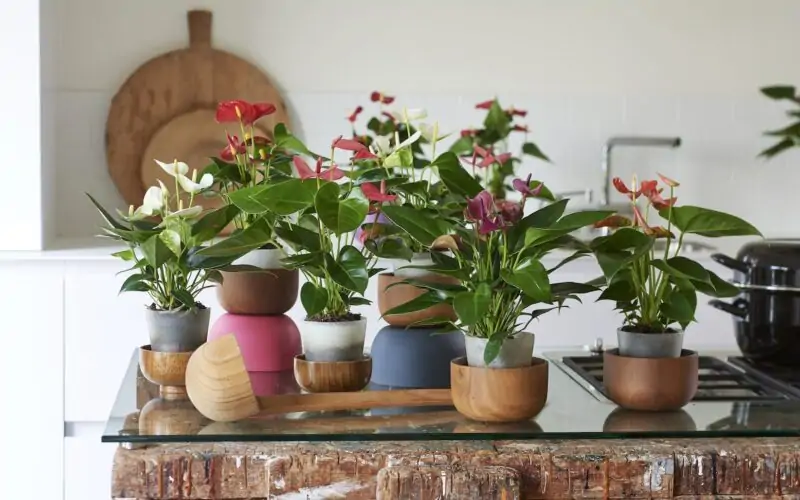Is Anthurium Toxic to Cats? The Guide to Flamingo Lily

Have you ever wondered is anthurium toxic to cats? While this gorgeous houseplant also known as the flamingo flower can add some serious style to your home décor, anthurium plants are also known for their toxicity to pets.

In this article, we’ll dive into everything you need to know about common types of anthurium plants and their effects on cats. From understanding what makes them toxic in the first place to learning how best to keep your furry friend safe from harm – let’s get started!
Understanding Anthurium and Its Toxicity To Cats
What is Anthurium?
Anthuriums are a genus of tropical flowering plants that belong to the Araceae family. Often called flamingo plants, they also come in a variety of colors such as reds, pinks, and whites with glossy green leaves. While considered common houseplants, they will thrive outdoors too. Their unique appearance includes heart-shaped flowers called spadix surrounded by bright-colored waxy bracts, which make them popular additions to floral arrangements.
Why Is Anthurium Toxic To Cats?
The danger lies not so much with its beauty but rather its chemical composition. Anthurium contains insoluble calcium oxalate crystals that are potentially toxic. This means that when ingestion of anthurium plants can often cause irritation, burning sensation, inflammation, difficulty swallowing, drooling, and vomiting.
It goes without saying that oxalate crystals that are toxic to cats and dogs of some breeds are no joke to these pets: it is always a good idea to keep your pets away from anthurium plants at all times. Ensure that your pets do not have access to or ingest any parts of this poisonous plant. Sometimes, if there is no other way to keep your anthurium safe from your cat and vice versa, it might be reasonable to decide on some other plant to decorate your home.
Signs Of Anthurium Poisoning In Cats
Cats may accidentally ingest anthurium by chewing on its leaves or stem. As soon as cats consume any part of the plant, the symptoms would start manifesting almost immediately. Some common symptoms of anthurium toxicity include:
- Irritation and swelling of the throat
- Drooling
- Vomiting
- Difficulty swallowing
- Difficulty breathing
Keep in mind that anthuriums are toxic to pets to a great extent. If your cat eats anthurium, this can lead to kidney failure and even death. This is especially true for situations when your cat managed to actually swallow (and not simply bite into) your toxic flower. If you suspect your cat has ingested any part of the anthurium plant, it is important to seek help from an experienced vet immediately: contact your veterinarian as soon as possible.
Veterinary Treatment For Anthurium Poisoning In Cats
Prevention is better than cure: to keep your pets safe, make sure that your cats don’t have an opportunity to be able to reach your beautiful plant. Treatment options for anthurium poisoning include rinsing out the mouth with water or milk, administering activated charcoal in a timely manner, as well as IV fluids if needed. When you take them to the vet, the veterinarian may also give your cats medications such as pain relief drugs to help alleviate symptoms while continuing to monitor vital signs until they stabilize.
Keeping Your Cat Safe From Anthurium Plants
Tips To Prevent Ingestion
Here is how you can keep your pet safe from poisoning to make sure that the cat’s away from the plants. The best way to keep your feline friend safe from anthurium plants is by preventing them from accessing these toxic houseplants altogether. Some tips on how we can achieve this are:
- Keep all toxic plants out of reach
- Don’t allow your cat to play with these plants: anthurium is poisonous and no toy!
- Place pots at high points not easily accessible
- Use deterrents like citrus sprays around areas where cats frequent.
- Watch your pets: keep a close eye on them and make it difficult for them to reach the source of the poison that is absolutely not safe for cats.
- Make sure you cat has enough toys to play with. Mice, fish, bone – everything will do that can draw your cat’s attention away from the toxic plants.
- If your cat really likes to bite plants, offer it decorative grass in a small container.
- If you have difficulty watching your cat, hang a small bell on its collar.
- Surround your plant with a decorative fence so that your cat cannot reach it with its paws. You can also use an aquarium for this purpose.
- Keep the plant as far from the rooms where you cat typically stays as possible.
- Close and lock the doors that lead to the rooms with your plants. Some cats are ingenious enough to open the doors with their paws.
- If you are really ready to invest into the safety of your cat (and plants), install motion sensor near your anthurium. There are models on the market that will text you or warn you in some other way when there is a motion nearby.
- You can also install a motion sensor equipped with a sound device that will shoo you cat away it it gets too close to the plant.
Remember that prevention is always better than cure!
Alternatives: Cat-Safe Houseplants
If you love your cats and want to keep them safe, your might want to look for some alternatives that won’t put your furry friends at risk but still add life to your space. Consider incorporating some pet-friendly non-toxic houseplants!
While plant materials from family Araceae are beautiful, anthurium plant contains toxic compounds that can cause irritation to the mouth. So, the absolute best way to prevent poisoning is to use some other non-toxic plants.
Some examples include Spider Plant, Boston Fern, and Areca Palm. All of them can be easily purchased: you can either buy via links on the Internet (people who recommend you these flowers may earn an affiliate commission, so you help your fellow gardeners by doing so) or visit your local nursery. Make sure to verify the safety of the plants before buying.
Alternatively, if your cat enjoys biting and chewing on any household plants you might have, you might contemplate switching to decorating your home with all kinds of non-edible decorative pieces.
Keep Pets Safe: Types Of Anthurium

Are All Types Of Anthurium Plants Toxic?
Yes. All types of anthurium contain calcium oxalate crystals which make them poisonous when consumed. Cats should be kept away from all varieties, whether red, pink, or white. Even touching these leaves could cause skin irritation, so it’s best practice not to have them within our pets’ environment.
Watch for changes in behavior of your cat that can be signs of toxicity in the mouth and tongue. If your cat ingests the sap from the plant, this sap can lead to irritation of the mouth and GI tract cavities. So, pawing at the mouth is one of the signs that your cat is experiencing unpleasant symptoms.
Is Red Anthurium Poisonous To Cats?
All colors are equally dangerous. Therefore, it’s essential to ensure that none of these plants find their way near our beloved felines. While the good news is that most cats get by eating these houseplants while experiencing only mild to moderate symptoms, you still need to keep them away from the source of danger.
Handling Anthurium Plants Safely

Proper Care And Maintenance
If you still choose to keep anthurium plants within your home, it’s important to handle them with care. This means wearing gloves when handling the plant and avoiding contact between its sap and skin.
Some basic tips for proper care include:
- Watering on a weekly basis
- Placing in bright indirect light
- Fertilizing every two weeks during the growing season
By following these guidelines, you’ll help ensure that both you and your furry friend stay safe from any potential harm caused by this toxic plant.
Protecting Pets From Toxic Houseplants
It’s always best practice to thoroughly research before introducing new houseplants into our homes. We should also be aware of which types of plants are poisonous or not so as to prevent ingestion. In case we find ourselves having already purchased some potentially dangerous ones, it’s crucial that they’re placed out of reach where cats cannot access them at all times.
FAQs (Q&A format):
No, it isn’t. However, if there is accidental ingestion through grooming, then symptoms such as oral irritation, drooling, and vomiting may occur. The same steps outlined previously, like seeking veterinary attention immediately, should be taken if suspected poisoning occurs.
Yes! All parts contain insoluble calcium oxalate crystals, which cause a burning sensation, inflammation, and vomiting, among other reactions. Therefore, cats must never have access to or ingest any part, even accidentally.
The amount needed for an allergic reaction varies depending on different factors, including cat size and the amount ingested. Generally speaking, just one bite could lead to serious health problems; therefore, prevention is key!
Cats can develop allergies to anything, including anthurium. Cat owners would notice symptoms such as sneezing, itchiness, and watery eyes when their cats come into contact with the plant.
Yes, there are tests that can help to reveal whether you suffer from an allergy. Contact your health practitioner to find out more.
Conclusion
So, is anthurium toxic to cats? Yes, they are: anthurium plants should be avoided in households where there are pets, especially cats. Their danger is real and can cause serious health complications if ingested. Prevention is key to keeping them out of reach or not having any at all within our environment. Let’s prioritize our feline friends’ safety always!